Welcome to the 2024 Hagerty UK Bull Market List, our annual exercise to identify and celebrate the vehicles we think will grow in value in the next 12 months.
The point of it all is not to tell you that you should be thinking of old cars as investments. Rather, we want to highlight some of the collectable cars that you can drive and enjoy today, which our data suggest will offer a bit of upside when the ride is over.
The vehicles presented below have been chosen by our valuation analysts based upon the fun factor they offer on the road and for the potential they offer to your bank balance. That first point is critical, and much easier to grasp: We all want to own cars that put a smile on our faces when we drive them, whether because they are fast, or because they are technically interesting, or simply because of their physical presence. It’s fun to be out and about in a great car. The second point can be harder to nail down, but the short of it is this: A classic car doesn’t have to be a financial burden.
This year’s selection of 8 vehicles was fuelled by close inspection of public and private sale results, Hagerty insurance quotes, and the patterns we’ve seen emerge in our market-leading Hagerty Price Guide. And, as always, our picks run the gamut, from practical workhorse to bonkers performance, from grand old luxury to the most whimsical little thing we’ve ever profiled. In the end, we hope you come away with an idea or two to help inform the purchase of your next classic vehicle.

1932–40 Alvis Speed 20 & 25
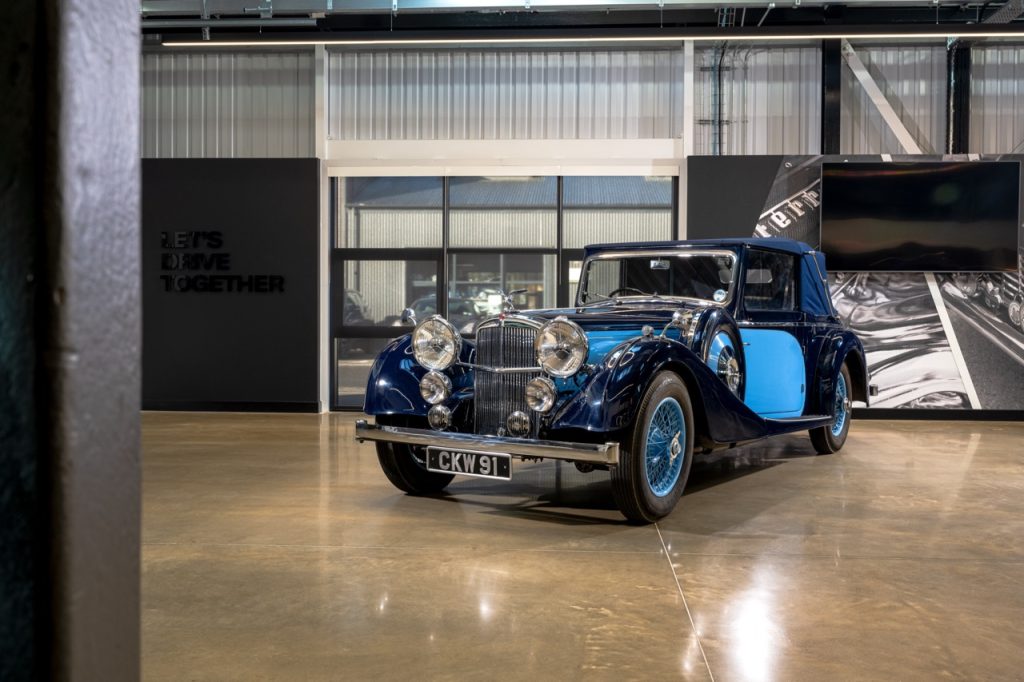
There’s a unique joy in operating a pre-war car, and for that reason alone we always try to include one in our Bull Market picks. This year it’s the turn of the Alvis Speed 20 and 25, cars that prioritised strong performance and confidence-inspiring handling in their day – qualities that today elevate them above more rudimentary alternatives from the era, and without the price tag of equivalents with more exotic nameplates.
Naturally, existing fans of the Alvis marque will be interested, but the real potential for cars from this era come from younger generations who are, slowly but surely, being introduced to models like the Speed 20 and Speed 25. Okay, so they’re not quite as accessible as last year’s Austin Seven, but as a true 1930s performance tourer, they’re possibly even more appealing.
Coventry-based Alvis made 1,165 Speed 20s between 1932 and 1936, across SA, SB, SC, and SD updates, and fewer than 200 Speed 25s from 1937 to 1940. Typical of the period, the models were built in several body styles, including two- and four-door sports saloons plus a drophead coupé in the 20, and as a four-door sports saloon for the 25. Various coachbuilders also rebodied them in racier formats, such as open two-seaters.
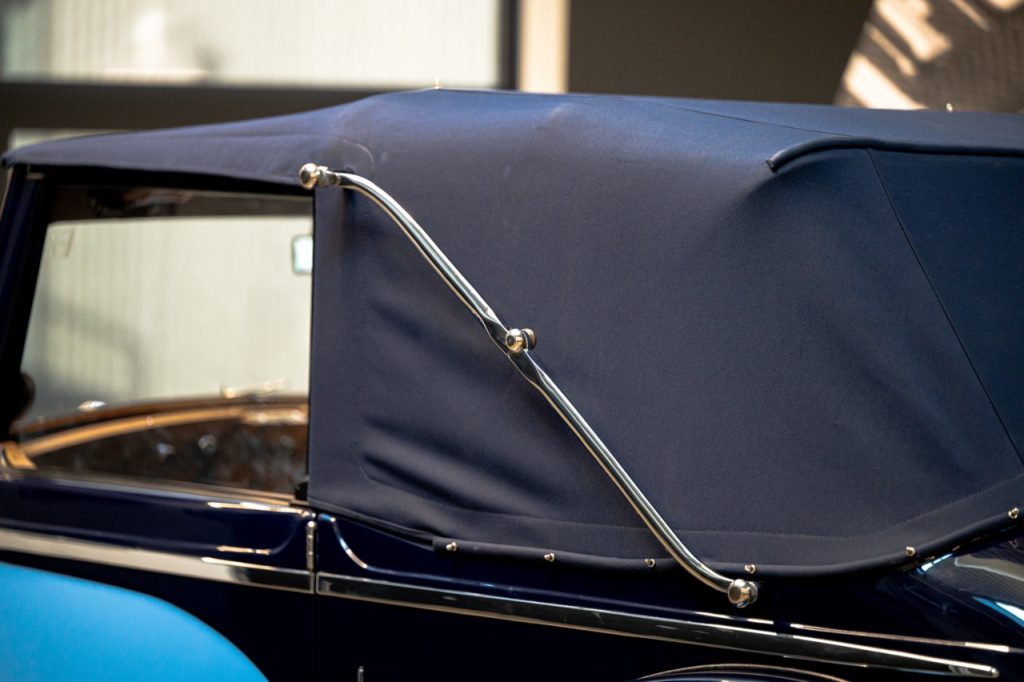


All Speed 20s used straight-six engines with a four-bearing crank and overhead valves, a derivation of the unit found in the earlier Silver Eagle. Capacities ranged between 2.5 and 3.6 litres in the 20 (the latter marketed as a 3½-litre, and aimed at bolstering performance as coachbuilders installed ever-heavier bodies), and the 25 got a much larger 4.4-litre six. All received a fully synchromesh four-speed manual transmission and independent suspension.
If that sounds quite sophisticated, then that was the aim, and reviews were positive indeed, commenting on the cars’ build quality, refinement, and ride quality, the latter tweaked to taste thanks to adjustable dampers. Writing in 1935, Motor Sport’s correspondent praised the 20’s ability to absorb the rough surface at Brooklands, the synchromesh gearbox’s ease of use (avoiding momentum-sapping pauses up hills while making unexpected downchanges much simpler), and the way the wheels ‘remained glued to the road at all reasonable speeds’. Another reviewer described the synchromesh changes in the 25 as ‘the best gear-change I remember’.



It was brisk, too, with 75mph easily attained – something that today makes this a prewar model that won’t wilt on motorway trips – and 83mph flat out, from the test car’s 2.8-litre, 20bhp engine and two-door saloon body. Even the headlamps came in for praise, though whether an owner today would still entertain ‘75mph after dark’, as Motor Sport did, is another matter…
The Motor Sport review also noted how the Speed 20 had improved over previous models tested, and this is worth bearing in mind today for any car you’re looking at – Alvis did develop and improve the car over time in detail ways that aren’t always apparent at a glance or from an auction listing, and you can assume later cars to behave with more composure and ability than early models.
As noted above, Speed 20s and Speed 25s cannot be considered cheap cars, but that’s fair enough, as they were quality items in-period, too. But just as they were in the 1930s, they also still represent excellent value.
1938 Alvis Speed 25 SC drophead coupé
Engine: Inline-6, 3571cc
Transmission & layout: 4-speed manual, front-engined, rear-wheel drive
Power: 106bhp @ 3800rpm
Weight: 1850kg (approx.)
Price range, Fair to Concours: £52,000–£99,400

What the Hagerty Valuation Team says:
The Alvis Speed 20/25 models are the epitome of classic British prewar sports cars, but values have softened a little over the last year. As a brand that no longer produces road cars – although the Alvis Car Company is creating some ‘continuation’ examples of historic models to order – marque recognition is relatively low with younger buyers. That means it may be overlooked.
That’s a huge shame. The Speed 20 and 25 are very capable sports cars with many features more often expected in cars built decades afterwards. Today, they will happily cruise along a motorway at pace with modern cars, but with Hagerty’s #2 (Excellent) value of the Speed 25 DHC at £81,600 – about half of that of a good Derby Bentley tourer – the Alvis offers a lot of value compared with similar cars of the era. Also, despite the lack of brand recognition, Hagerty Price Guide average values of all Alvis models have risen from £43,077 to £56,867 in the past 12 months, a climb of 32 per cent.

1949–71 Austin J40

The Goodwood Revival could be credited with renewing interest in numerous largely overlooked and forgotten cars, but perhaps no model has garnered greater attention than one that doesn’t even have an engine: the Austin J40.
The photos will have given it away already. The J40 isn’t one of Austin’s 1950s family cars, packing a tuned A-series and driven at great speed by the likes of Andrew Jordan. Instead, it’s a pedal car aimed at rather smaller members of the family, and for a decade now the Revival has hosted a race for a grid full of them and their diminutive pilots, called the Settrington Cup.




It’s this race that has really put the J40 on the map, according to Mark Burnett, managing director of Austin Pedal Cars, a company that is to these vintage pedal cars what Alfaholics is to 105-series Alfa Romeos. The firm sells, services, and restores the little cars, ships parts worldwide, and Burnett and his team last year acquired the Austin trademark, allowing them to trade under the Austin Pedal Cars name. They’ve even created a continuation model, which was launched at 2022’s Revival.
The J40 has its roots in the immediate postwar period, with a prototype developed in 1946 that took its styling cues from the contemporary Austin 8. Production started in 1949 and continued all the way until 1971. If you were a young child in the ’50s or ’60s, there’s a fair chance you drove one at some point, with more than 30,000 produced – 32,098, to be precise. Out of production now for more than half a century, survivors are relatively rare.
That attrition, plus growing demand, means prices are about what you’d expect from the A-series–powered A40 mentioned above, with basket cases from around £1,500 rising to £10,000 for one in #1 (Concours) condition. A good one ripe for restoration is around £4,000, while Burnett notes that the J40’s predecessor, the Pathfinder, can be even more valuable.

A race history also helps. “Ex-Settrington Cup cars come at a premium,” says Burnett, “as do other interesting cars, like those used by the RAC for road traffic awareness. People do buy them for their kids, but also as ornaments or art.”
Your Hagerty authors are all a little too big to offer driving impressions, though as the front-runners in the Settrington Cup have shown, performance is very much down to the driver’s determination and deft legwork, and handling is more influenced by the driver’s height and weight than it is in even the lightest of Caterhams.
Still, if the price of entry seems high and makes you wince every time little Timmy spins off into the flower beds, know at least that classics come no easier to maintain, or indeed to store and display. And not many other classics get their own, dedicated race at an event like the Goodwood Revival, either.
1949–71 Austin J40
Engine: Dual-foot pedal
Transmission & layout: Slow/fast-twitch muscles, front-pedaled, front-wheel drive
Power: 0.1bhp @ 40rpm (est.)
Weight: 43kg
Price range, Fair to Concours: £1,500–£10,800

What the Hagerty Valuation Team says:
The J40 is an unusual pick, as it could be considered a toy, but try telling that to the collectors and the families whose children take part in the Settrington Cup at Goodwood. The J40 has become collectable in its own right, with the same features prized on collector cars making a difference in value: originality, provenance, and restoration quality in particular.
Why should Hagerty include this now? The J40 is something that can be easily stored and shipped worldwide, is (compared to full-size classics) relatively inexpensive, and may introduce a younger generation to the love of motoring. Although values have increased significantly over the last few years, demand still massively outstrips supply.

1994–97 Daimler Six

Every year in the Hagerty UK Bull Market, we aim to include at least one car that almost anybody could go out and buy. The X300-generation XJ and Daimler Six are the perfect examples of a car that doesn’t need an endowment to afford, which is ironic as the Jaguar XJ and its ilk still have more than a whiff of ‘old money’ about them. In the right condition and colour, there’s definitely something of the family heirloom about it.
Sam Skelton, editor of the magazines Jaguar World and Classic Jaguar, explains it with perfect clarity: “For my money it’s the last proper saloon made by Jaguar, and the better-spec ones make you feel really special.” If you’re looking at the Six, then part of that is rarity, since the Daimler made up only around one in 100 X300s sold. Skelton’s car cost a whopping £60,000 new, with a further £6K of options, including heated and electric rear seats, and a paintwork colour used on the Queen’s car.



Not all X300s were quite so well-specified. As Skelton points out, it was possible to get a basic XJ with cloth trim, a manual gearbox, wheel trims rather than alloys, and even forego air conditioning. While these XJs still have charm (and presumably, give you fewer things to poke around at when inspecting a car), it’s the higher-specification cars that are more desirable, and which are much more becoming of the X300’s luxury aspirations.
Skelton advises buying on condition, rather than spec. You can always upgrade a lower-spec car with the right parts, but because X300s have fallen down to the bottom of the market over the last decade or so, poor examples are still out there.
“The 3.2 is slower and thirstier than the 4 litre, but not by much” he says. “And the XJR costs more to own and maintain. Daimler models tend to be maintained a little better than Jaguar and may be a little more expensive as a result.”



The X300 was very well regarded when new, despite a few flaws inherited from its XJ40 predecessor. Styling was a marked improvement, evoking the original XJ6 and banishing the XJ40’s boxiness (easier to stomach though the latter now is), and while Jaguar did sacrifice passenger space for style, interior quality took a step upwards.
And if the XJ40 drove well, the X300 improved on it further. Journalists commented on the car’s newfound steering precision and better body control, with no notable loss in ride quality; this Jaguar (or Daimler) glides with the best of them, something enhanced by its smooth straight-six or, in the ‘Double Six’, V12 engines. Skelton notes that the government often picked V12s as ministerial cars, though don’t let the chance one was owned by an unpalatable politician put you off…
Interesting to think, too, that as Jaguar was launching the X300, Land Rover debuted the P38A Range Rover. One an older car comprehensively refreshed for the 1990s, the other a resolutely 1990s car trying not to lose all of its 1970s roots. The P38A was good, but we think the X300 might just have done better job of meeting its goals. Today, you can find out just how well for only a few grand.
1995 Daimler Six
Engine: Inline-6, 3980cc
Transmission & layout: 4-speed automatic, front-engined, rear-wheel drive
Power: 237bhp @ 4800
Weight: 1825kg
Price range, Fair to Concours: £1,600–£12,500

What the Hagerty Valuation Team says:
The X300, and particularly the Daimler Six, is on our list as it is an almost ridiculously cheap car which offers a huge amount of motoring for the money. With even the best examples in the world, in #1 (Concours) condition with superb spec, being worth just over £10,000 and driving examples available for under £2,000, this is a practical, stylish car. Plus, with many being scrapped each year, they are becoming evermore rare. With the earliest cars now 30 years old, they are quickly moving toward the zone of being a true classic.

1985–91 Ford Escort RS Turbo
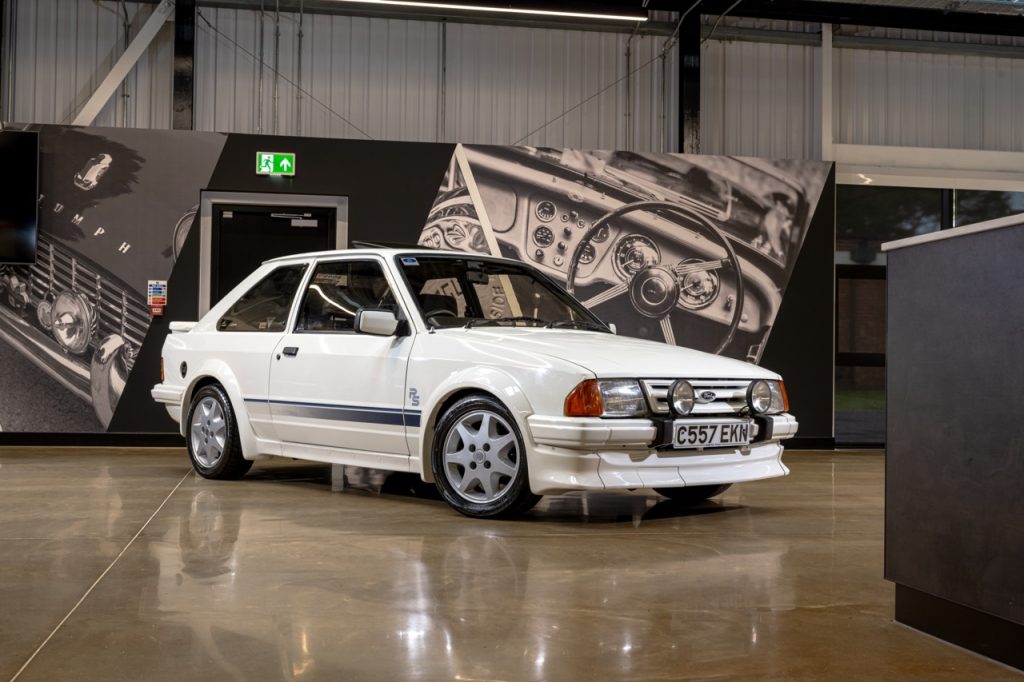
The Ford Escort RS Turbo may not rank near the top on the list of the best-handling hot hatchbacks, but for capturing the zeitgeist of 1980s Britain, it ranks very strongly indeed. Like Ford’s Cosworth models, it was an aspirational version of a car you’d see by the hundreds on the roads every day, making it, to coin a phrase Ford itself used in an earlier period of its history, ‘the car you always promised yourself’.
It has also shot back into the limelight in recent years thanks to a few high-profile auction results. A £60,000 result back in 2015 with Silverstone Auctions (now Iconic Auctions) raised several eyebrows, but the market soon settled again. That was until Princess Diana’s 1985 RS Turbo, in black with some SVO special features, sold (once again through Silverstone Auctions) for an astonishing £722,500 in 2022.
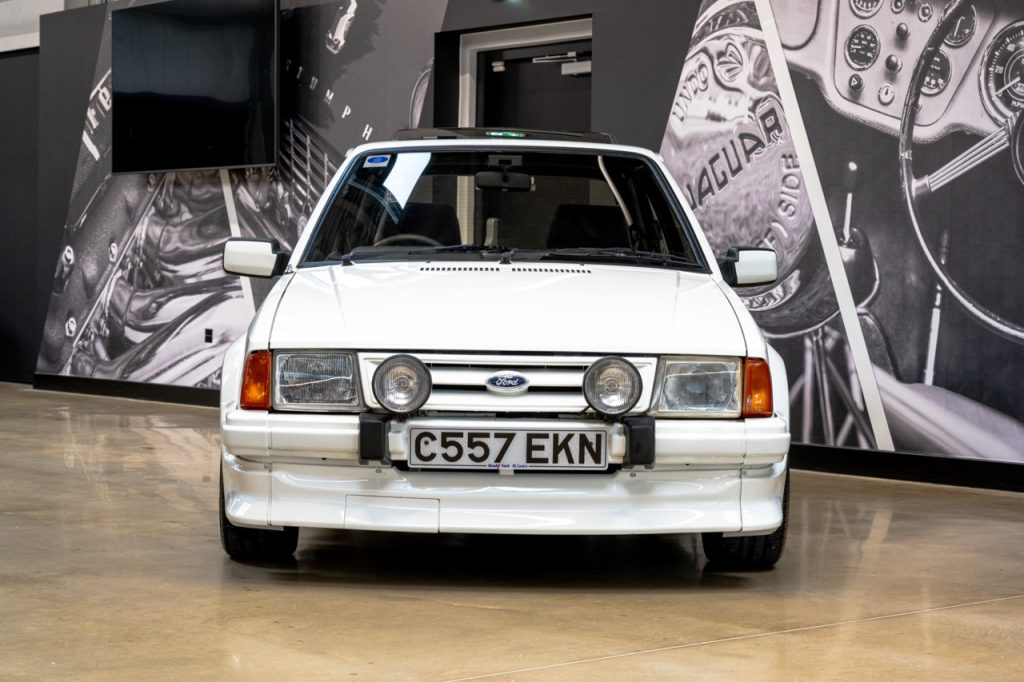


Such an anomalous result hasn’t shifted the needle much again, but there’s no doubt the RS Turbo isn’t quite as blue-collar as it used to be. Ford fans who grew up lusting after the car in the 1980s had already created a strong following, and values went up accordingly, just as they have for so many other fast Fords over the years.
But is there merit to the RS Turbo simply as a car in its own right? Owner Gareth Blair, who brought this car along to our shoot, gives plenty of reasons as to why it might be.
“If you’d told me 25 years ago that this car or any of the RS Fords would be collectable, it would have been mind boggling. I got into the cars because of TV: Minder, The Professionals and Leslie Ash in C.A.T.S. Eyes. Driving this now takes me back to that happier age and when I take it out, people all want to talk to me and I end up ‘pump blocking’ every time I go for petrol.


There’s no doubt an RS Turbo still stands out today, even amongst other popular Fords of the era like the XR3i and Mk3 Capri, with its deep bodykit, distinctive wheels (seven-spoke on Mk3-based cars, six-spoke on Mk4s), spotlights, and inside a set of well-bolstered Recaro seats – though Mk3s arguably get the more appealing steering wheel, a three-spoke RS item rather than the Mk4’s humdrum two-spoker.
“The ones to look for are those that have been unmolested” says Blair. “This one has never been resprayed, no roll cage fitted, and even has the original graphics and the Ford radio cassette. It has the ‘custom pack’ sunroof [an option that also added central locking and electric windows], it sounds good on the road and drives really tight. Really important for me is the social aspect – the clubs and registers. It’s not just another car.”
‘Not just another car’ rather nicely sums up the RS Turbo’s appeal, we reckon. A VW Golf GTI might be better built or a Peugeot 205 GTI more engaging to drive, but both are almost too obvious among 1980s hot hatchbacks. The RS Turbo somehow looks and feels more exotic, and despite a few high-profile sales, it is more of a dark horse. Even in its typical Diamond White…
1986 Ford Escort RS Turbo
Engine: Inline-4, 1597cc, turbocharged
Transmission & layout: 5-speed manual, front engine, front-wheel drive
Power: 130bhp @ 5750rpm
Weight: 975kg
Price range, Fair to Concours: £8,200–£35,800

What the Hagerty Valuation Team says:
When the sale of a classic car sets a new world record, Hagerty are always asked by other owners of the model whether their car has increased as a result. The answer is… maybe. Princess Diana’s RS Turbo went for a full £687,500 over Hagerty’s top value for the model, but since then, that value has only increased a little with our #1 ‘Concours’ value now £35,800.
Whilst everybody accepts that Diana’s car was a one-off, it undoubtedly drew attention to a model that hadn’t gained as much of the limelight as some of its other fast Ford stablemates. Hagerty’s average values for all Ford RS/Cosworth models have risen from £29,886 to £42,225 over the past five years, with the Sierra RS500 Cosworth gaining nearly a third more value in the past two years, with a #1 value now just over £100,000. The Escort RS Turbo has so much going for it – a homologation special, the Blue Oval on the bonnet, and now a record sale – that Hagerty believes it is good value.

1999–2010 Honda S2000

If cars like the Honda NSX and Nissan Skyline GT-R fronted the first wave of legendary Japanese performance cars in the late 1980s and early 1990s, then the Honda S2000 headed the second wave as the automotive market crested the new millennium.
The first wave had been developed when Japan was flush with cash in an economic bubble, but while that bubble had burst in the early 1990s and carmakers were a lot more cautious toward the end of the decade, Japan was showing no outward signs of slowing down.
The S2000 arrived in ‘AP1’ form in 1999, the same year as Nissan’s final Silvia sports car (not offered in the UK). This was swiftly followed in 2000 by the third-generation Toyota MR2, and by 2002’s Mazda RX-8 and Nissan 350Z, while the Mitsubishi Lancer Evolution and Subaru Impreza WRX were both still going strong as the new decade dawned. It was a good time to be a fan of Japanese cars.




The S2000 was typically Honda in its execution, its centrepiece being a high-revving 2-litre four-cylinder petrol engine, called the F20C in Honda circles. Driving the rear wheels through a six-speed manual gearbox of switch-like precision, it made 237bhp at 8,300rpm. The chassis used double wishbones at all four corners, and steering assistance was electric. As was the roof, which once unlatched could fold in only 6 seconds, about the same amount of time as the car’s dash from 0 to 60mph…
A 2004 update varied depending on where you lived. The US and Japan’s ‘AP2’ generation received a 2.2-litre engine that improved upon the 2-litre’s meagre 153lb ft of torque, but UK cars got the AP2’s styling and chassis tweaks (the latter aimed at taming the sometimes wayward handling mentioned in the early press reports) while keeping the 9,000rpm F20C.
Drive an S2000 today and as we’ve written before, it can be a mixed bag. The styling is still great both inside and out – surely one of Japan’s best-looking roadsters – and while the seating position is a touch high and the steering wheel is fixed, the LCD tachometer ahead of you, inspired by Senna’s McLaren-Honda racers of the early 1990s, is truly evocative.


On the move, though, you need to keep that whole tachometer lit up, and not just in the sense that all naturally aspirated engines do. We mean a constant stoking of near-maximum-revs to truly release its potential, though a fabulous gearshift makes this easier than it might be. That electrically assisted steering is a weak link though, with very little feedback to connect you with what is otherwise a well-balanced chassis.
Based on internet discourse, however, the S2000’s owners and fans either don’t notice or don’t care about these deficiencies, and they’re perhaps less apparent in the car’s larger US market, where generally drier weather, better surfaces and fewer speed cameras mean you can access more of what the ‘S2K’ offers, more of the time.
You need to keep your eyes open when buying an S2000 since they’re prone to hard use and are now becoming susceptible to corrosion, but being a Honda, they’re still less trouble than most. And if you click with the S2000’s way of thinking, sports cars don’t come much more appealing.
2009 Honda S2000
Engine: Inline-4, 1997cc
Transmission & layout: 6-speed manual, front-engined, rear-wheel drive
Power: 237bhp @ 8,300rpm
Weight: 1274kg
Price range, Fair to Concours: £11,500–£22,000

What the Hagerty Valuation Team says:
This car is a demographic pick. It has really hit Hagerty’s radar this year, with the number of policies added globally in 2023 already 17 per cent higher than last year, a rate five times that of all vehicles. It’s a car that really appeals to younger drivers: 59 per cent of policyholders are aged 49 and under, with 17 per cent under age 30. That’s a stark contrast against, say, the BMW Z4, where only 6 per cent of policyholders fall into the under-30 demo. The Honda’s demographic figures for young people have increased by half since January 2020, and at this rate of change, Hagerty would expect more under-30 owners than over-50 owners by next year.
Values have been rising accordingly, too. An AP1 S2000 is now worth what an AP2 was valued at two years ago, and the later model has gained 20 per cent in value in the same time period.

1969–75 Maserati Indy
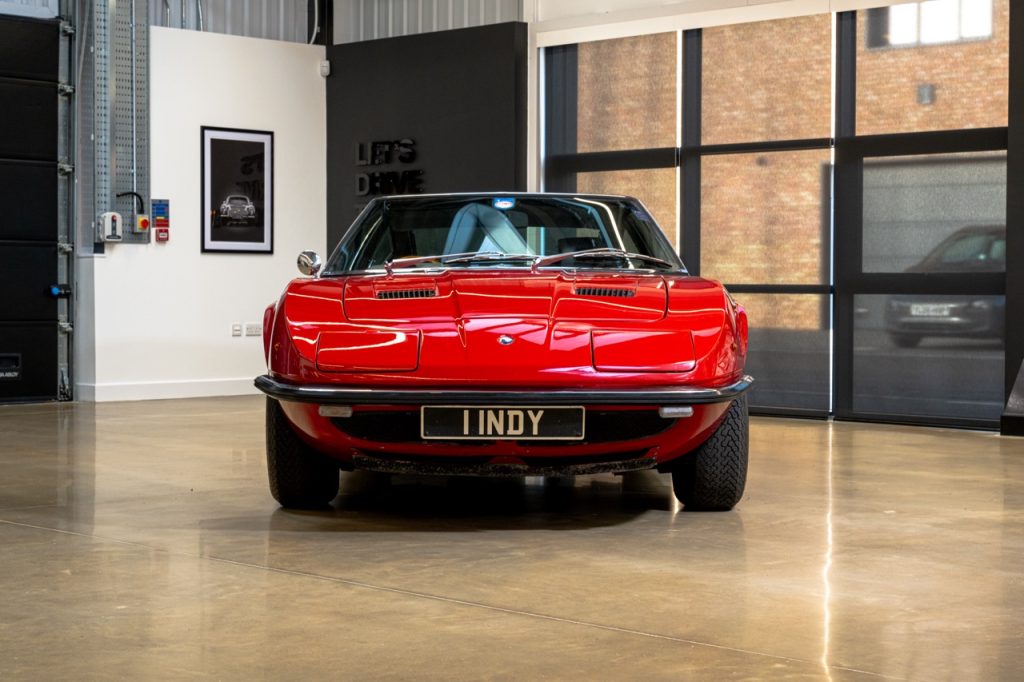
The Maserati Indy is yet another car we picked for this year’s list because it currently represents great value for a car of its style, driving qualities, and heritage. In concept the Indy competes with heavy hitters like the Ferrari Daytona, but is an order of magnitude more affordable than its Modenese rival.
The Indy is certainly a more demure, less bombastic shape, without the Daytona’s deference to striking details. The Indy’s coachwork was the work of Vignale, specifically Virginio Vairo, and it definitely shares hints of some of his other work, such as the slim chrome bumpers, sharp creases dividing the bonnet from the body sides, and its fastback silhouette.
The name, meanwhile, has its own backstory, celebrating Maserati’s two victories at the Indy 500, albeit somewhat late: Maserati won the famous race in 1939 and 1940, and the Indy arrived a full 30 years later, running from 1969 until 1975. Still, better late than never.



Power initially came from a 256bhp, 4.2-litre, 90-degree, quad-cam V8, with capacity expanded in 1970 to 4.7 litres (with 286bhp) and again in 1972 to 4.9 litres (with 316bhp). The Indy you’re looking at will denote its capacity in its name: 4200, 4700, or 4900. Maserati built 1,104 cars in total, marginally weighted in favour of the 4200, then fewer of the 4700 and fewer still of the 4900.
The Indy came as a 2+2 and was luxuriously appointed. Maserati offered the car with an adjustable steering column (with a steering lock to deter theft), leather seating, tinted electric windows, fog lights, a heated rear window, and, like so many Maseratis since, a clock incorporated into the dashboard, though aimed at the passenger in this instance. Power steering and an automatic gearbox were optionally available, and in 1973, the model incorporated hydraulic power braking courtesy of its new owner, Citroën.

Michael Roberts, chairman of the Maserati Club and owner of the Indy 4700 in our photographs, has added a few of his own technological touches to improve usability, most notably a keyless ignition system to cut down the jangle of the five keys his car originally came with. Roberts has owned this Indy since 1992, and after a rolling restoration over seven or eight years, it’s now a surprisingly usable and even reliable car.
The Indy was conceived as a grand tourer, and that’s a role it fulfils perfectly. “I once managed Monaco to Dover in eight hours… and I’ve taken it back to Italy, where they still really appreciate them,” says Roberts, adding that the seats in particular are fantastically comfortable for touring. Sitting between the Mexico and Ghibli, the Indy aimed to blend some of the former’s practicality with the latter’s more rakish lines. And it really is practical; despite the ‘plus two’ billing, actual human adults can fit in the rear seats, and there’s a sizeable boot, too, accessible by a hatchback.


It’s less intimidating in size than the Ghibli, but later models with their larger engines are nearly as quick, and Roberts describes it as sounding “wonderful and exhilarating to drive wherever you are.” Those who’ve tried the Citroën-braked models, meanwhile, find them predictably powerful once you’re used to the different pressure they require; for the handful of Indy buyers who might be migrating from an old Citroën, it would no doubt be an easy transition.
So, it’s not really a Daytona rival at all, but a classy grand touring car in its own right, with its own appealing facets and a focus on effortless performance and surprising accommodation. It could, in fact, be worth a look if the Ghibli is already on your radar, offering many of that car’s benefits but at a much more affordable price. And if you go the Indy route, Maserati Club membership is highly recommended too, for both the camaraderie and expertise.
1972 Maserati Indy
Engine: V8, 4719cc
Transmission & layout: 5-speed manual, front-engined, rear-wheel drive
Power: 286bhp @ 5500rpm
Weight: 1572kg
Price range, Fair to Concours: £39,000–£69,000 (4.7L)

What the Hagerty Valuation Team says:
The Maserati Indy is on the list because prices have dropped, and Hagerty now believes it offers great value for money.
Just prior to the pandemic, Hagerty’s condition 2 (Excellent) value peaked at over £80,000 for the 4.9-litre model, but that has dropped back to £69,200, a value last seen in 2016. Numerous no-sales at auction have affected the model’s attraction to some buyers, but fundamentally it remains a great classic.
Offering loads of power, even from versions with the smaller engines, the car is a proper grand tourer with loads of space inside. Compared with its Ferrari counterpart, the Daytona (which has also seen its value drop), it is now superb value.

2011 Porsche 997.2 GT3 RS 4.0

On dynamic grounds, the Porsche 997 GT3 RS 4.0 needs absolutely no introduction. It’s often deemed one of the greatest 911s of all time – and therefore, one of the greatest driver’s cars of all time. Evo voted it the best car they’d ever tested, in the magazine’s 200th issue, and while later GT3 RS variants have been even more extreme, the 4.0 remains one of the lightest, along with being more compact than later cars while hanging onto hydraulic steering assistance.
As the name suggests, the 4.0 used a four-litre variant of the 3.8 found in the regular RS. It’s one of the final evolutions of Hans Mezger’s flat-six, differentiating it from both its other watercooled contemporaries (outside of the Turbo models) and the all-new engines that arrived with the 991 generation of 911 that followed.

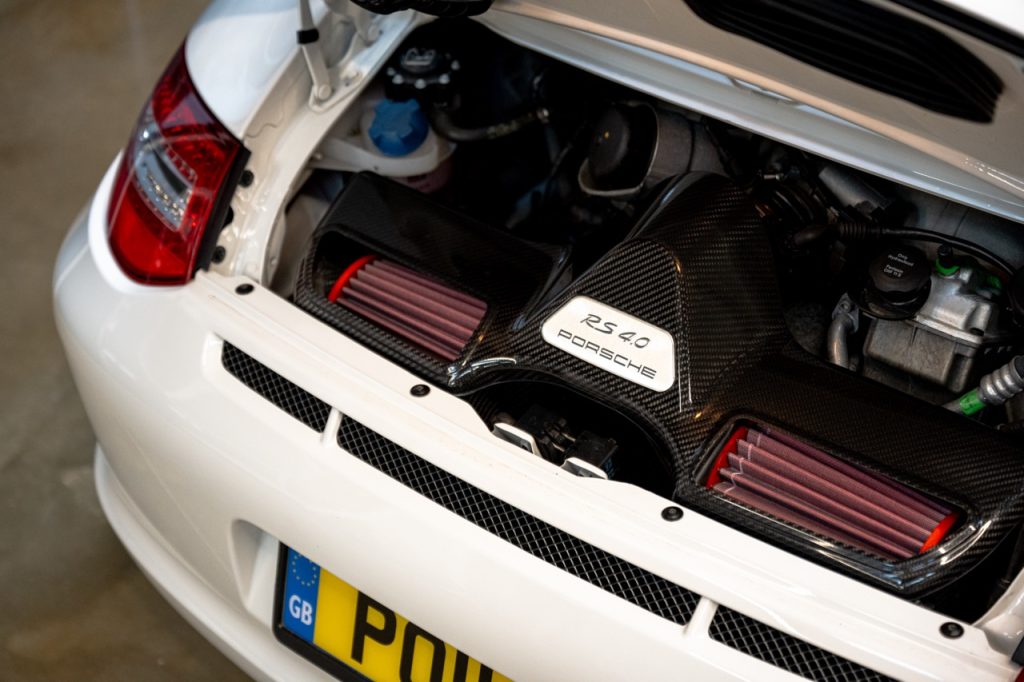

Its power figures still sound healthy today, if not quite as barmy as some modern performance cars: 493bhp at 8,250rpm, and 339lb ft at 5,750rpm. That’s enough for 0–62mph to sneak in a couple of tenths under the four-second mark on the way to a 193mph top speed, despite the aero drag of its sizeable front splitter and rear wing. Notably, it still used a manual gearbox, rather than a PDK dual-clutch auto, and the rear suspension was from the mighty GT2 RS. The GT3 RS 4.0 is rare too, as Porsche made only 600 during the 2011 production run.
The car in our photos is owned by Simon and Polly Webb, and it sits alongside other Porsche greats in their collection such as a 2.7 RS and 964 RS. It had also just come back from a road trip to Geneva, so while RS models have a reputation for being intense experiences, they’re not completely out of depth on longer trips, either.



“Compared with the modern 911s, this has a smaller place on the road and it feels light,” explains Simon. “The last of the naturally aspirated Mezger engines is brilliant – it revs to 8,500 but you don’t have to think what gear you’re in, as it has power everywhere. Some of the refinements from the RSR racing cars, like the rose-jointed front end, give it a real precision.
“We had six days’ worth of luggage and filled the car full of wine on the return journey without any hassle. It’s flexible and brilliant everywhere, from mountain roads to Sainsbury’s car park. It’s more compliant than the 964 RS.”
Simon’s due diligence turned up a car in his preferred muted colour scheme, with cornering headlamps, the carbon pack, and low mileage, while he had the paint checked for thickness and the ECU for over-revs of the engine, too. All seem wise if you’re checking a 4.0 out for yourself, but these cars are remarkably stout in their own right, for something so focused. They could very well be peak 911.
2011 Porsche 997.2 GT3 RS 4.0
Engine: Flat-6, 3996cc
Transmission & layout: 6-speed manual, rear-engined, rear-wheel drive
Power: 493bhp @ 8250rpm
Weight: 1360kg
Price range, Fair to Concours: £290,000–£560,000

What the Hagerty Valuation Team says:
The 997 GT3 RS was only added to the UK Hagerty Price Guide in 2022, so price trend data is still young, but the model has many of the characteristics that Hagerty believes mark out a collectable, from its last-of-the-line engine to its analogue driving feel.
In value terms, the 997.1 fitted with the 3.6-litre engine still suffers from reputational issues, although most cars will have had those addressed. Values increase for the 3.8 (Gen 2) cars and peak at the 4.0-litre models due to their ultimate status and limited production. Whatever the generation, the very best cars demand a significant premium; values for #2 (Excellent) 3.6-litre cars have increased by 35 per cent since 2017 but are up 66 per cent for #1 (Concours) cars.
Nearly 70 per cent of Hagerty’s quotes comes from people aged 50-plus, but Porsches transcend generations, and demand consistently surpasses availability.

1996–2003 TVR Cerbera

The TVR Cerbera was named for Cerberus, the three-headed hound guarding the entrance to Hades, and sometimes it feels like you need three heads to operate a TVR: one to drive it, another to keep an eye on its vital signs, and third to appreciate just how spectacular the Blackpool carmaker’s machines can look inside and out.
The Cerbera is definitely among the easier TVRs on the eye, and that’s in the face of strong competition. It launched in 1996 but still looks spectacular today, not aggressive like a modern performance car but low-slung and muscular, with a cabin that feels like a cross between something by Salvador Dali and the work of generative design.
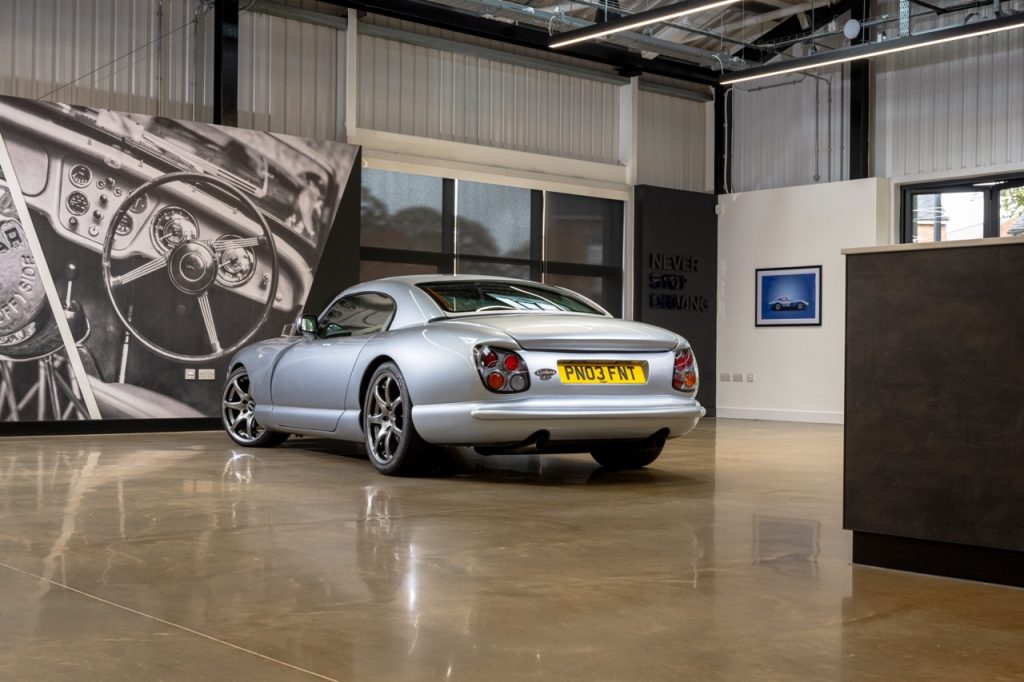


With your design head satiated, it’s on to the monitoring head, as TVRs from this period have a somewhat dubious reputation for reliability. But according to Jason Clegg, who runs TVR specialist Str8six and brought this car along, that’s less of a hurdle these days.
“The problem was that the factory didn’t finish them off,” he says. “Especially the earlier ones, and the reputation suffered as a result. They had a ridiculously cheap list price given that everything – suspension, engine, even switchgear – was made by TVR.
“What has happened since is that passionate owners have invested money to remedy the problems and fettle them into the shape they should have been in the first place. That said, the late cars are much better than the early ones anyway.”
Clegg’s advice then is to buy the best you can afford, as there’s “no such thing as a cheap TVR,” and lower-priced examples will almost certainly need the most work from the get-go. The high-power Red Rose versions (440bhp from TVR’s own 4.5-litre, 75-degree V8, compared to 350bhp from the in-house Speed Six) are the ones to have if your budget can stretch, while the ‘Cascade’ flip paints are also more desirable now than they were new.

So, will your third, driving-focused head appreciate it? Absolutely. TVRs have a scary image but they’re far better to drive than you might expect, and the Cerbera is from the same breed. A long-travel throttle pedal serves as de facto traction control and a firm, progressive brake pedal does the same in lieu of ABS. Cerberas have a balanced chassis, too, and even the ride’s not bad, while TVR’s in-house engines are brutally powerful in such a light chassis (even a Speed Eight is only around 1100kg, similar to a modern Alpine A110). They sound magnificent, too.
And while prices are firm today, a Cerbera still represents good value for the performance and design on offer, with the most affordable models only new MX-5 money and the very best on the market a good chunk less than a Boxster. You don’t need three heads to appreciate that, but it helps.
2003 TVR Cerbera
Engine: V8, 4475cc (Speed Eight Red Rose)
Transmission & layout: 5-speed manual, front-engined, rear-wheel drive
Power: 440bhp @ 7250rpm
Weight: 1190kg
Price range, Fair to Concours: £27,100–£41,200

What the Hagerty Valuation Team says:
The TVR Cerbera is another model that Hagerty sees as being good value, and after several years of flat prices, average values have started to creep up, increasing nearly 3 per cent in the past 18 months, from £25,513 to £26,181. Top-of-the-range Red Rose models have increased even more, with the best having recently surpassed the £40,000 barrier. That’s still not a lot of money for an extraordinary British sports car, one that turns heads and has such an analogue driving experience.
As Hagerty has often written in the past, models with a rather poor reputation when new (think 996 Porsche 911, Jaguar XJ220, etc.) often outgrow this as the years progress and the original issues are overcome, leaving the car perceived in a new, more generous light. It may be time for the Cerbera to undergo this transition.

***










How is the S2000 on this list? Such a deeply flawed car. Motorbike engines belong in motorbikes.
Similar Daimler used to live in Ormskirk with a unique (damson?) paint job. Off my radar now, I think its ex police officer owner died. Hopefully my small collection of Rovers – a 45 V6 connoisseur, 200vi and 216 cabriolet in amaranth might make the list one day; just need a tourer for the full pack…
The TVR Cerbera is a flawed car, but it probably deserves to be there.
Was not aware of many flaws in the Honda S2000. Not owned one myself, although i have friends who have and they were more than complimentary about them.
Correction to your spec; the Austin J40 is “Rear Wheel Drive”.
The S2000 might be a nice car but having to rev the engine to 8K to leave the driveway got old very quickly !
Wow, 8k revs just to leave the drive.
That is a lot.
8000 K just to leave the driveway do you live at the bottom of a very steep hill???
Suprised a Jensen Intercepter 1 did not creep in to the list, seems to be a lot of barn find, refurbs and rebuilds peppering the autions and whilst there is an industry supporting them.
There are a few cars on this list, like the Jag, that are not ULEZ and I can’t see them increasing much in value because of this. They are ‘usable’ daily’s. Except they are not at £12.50 per day. That reduces the pool of buyers by several million in London and other cities. Buyers will turn to cars over 40 years old and post 2006 (in many cases like 986 and Elise 1998) that are ULEZ. ‘Normal’ cars 1984 – 2000 will struggle to sell due to ULEZ restrictions.
Interesting to see the Honda S2000 in this list. Personally I’m not convinced it should be here. Prices of these went up significantly a couple of years ago, but have since dropped a fair chunk. I know because I bought one and sold it for a tidy profit, before the prices dropped
Please to see somebody else plugging the Jensen Interceptor, particularly the original Mk 1. A much under-rated and undervalued car when compared with (say) the Aston Martin V8’s
When I opened this page and saw the Alvis portrayed my heart skipped a beat, a reminder of opportunities missed! Way back in Dec 1964 a friend and I set off for Perivale from S. Wales in his Mini Pick Up to take a look at and hopefully buy a 1954 Jaguar XK 120 DHC, advertised in Exchange and Mart for £90! The pick up had all the tools etc we may need in the back and a highly tuned Cross Flow headed, Amal Carbed engine in the front; very quick but unreliable! Consequently, running late, we stopped in High Wycombe to phone and advise the seller of this and, assured he would stay open for us, emerged from the Phone Box (remember them) to see something interesting in a showroom window across the way. It turned out to be a 1933 Alvis Speed 20 SA Long Winged Tourer. In the showroom the car looked scruffy but sound. My friend, an “Austin” trained Automotive Engineer with a Vintage bent, having cast his eye over and ear to the car was of the opinion that at the price the seller was asking, £160, it was well worth taking a punt. With his own fledgling business, he also assured me that it was well within his capacity and ability to maintain while giving me the opportunity to improve my own skills in that direction. Sadly, between us we couldn’t raise the required sum, below which the seller refused to budge. I had scraped together £100, £90 for the car and ten for eventualities on the 140 odd mile return trip home from Perivale. He had £6 and change! Different times! Disappointed we carried on Eastward. The XK turned out to be an even better bet than the Alvis, smooth running motor, good interior, some, but nothing too problematical, rusty patches and a run up and down the adjacent A40 that every bit of Lyons, Heynes and Jaguar’s brilliance still existed in abundance. On return a quick check over showed all seals intact, no leaks, only a suggestion of a mild exhaust blow. The hood was tatty in the extreme and there was no spare wheel and this plus a few other odds and ends allowed us to negotiate the price down to £80 and paperwork exchanged in each direction, we set off home. The small, tight cabin of the pick up proved to be a life saver. The outside temp. had dropped to about -1C and twenty odd miles in the open XK proved to the limit of our endurance. Pause, swap over, de ice and carry on until flashing headlights from the XK meant a repeat of this performance. We were young but sometime as one reluctantly exited the Mini one was reminded of Cap’t. Oates last words to Scott and his comrades. “I’m just stepping outside. I may be sometime”. After some fettling, an exhaust rebuild, a renewed Hood, a spare wheel, springs and other odds and ends from a nearby Jaguar dealer who raced a couple of 120s, kept me and the car on the road for a monumentally enjoyable further 14 yrs, exploring the length and breadth of the country and the cars performance, sadly reduced by the introduction of a 70mph limit in the early ’70s. Expense was kept down as the car was my sole means of transport and it got used for business trips as well as personal, my MD rewarding me with healthy expenses to help maintain the car (It impressed customers, particulary the American ones who enoyed nothing more than a trip down to the nearby Thatched Pub for for Roast beef, Yorkshire Puddings and Warm Beer lunch). Oh happy days! The Alvis was a disappointment but the XK more than made up for it.
Sorry to go on a bit and not address in the slightest the direction of this article but at my age ‘Might have Beens’. become a major part of one’s motoring recollections. I won’t be offended if you omit this piece if you don’t think it has any relevance.
What a wonderful reminiscence, thank you!